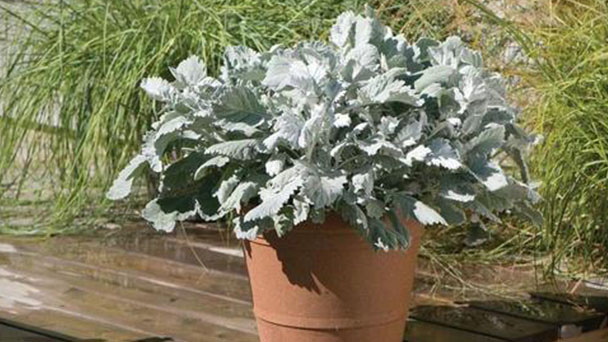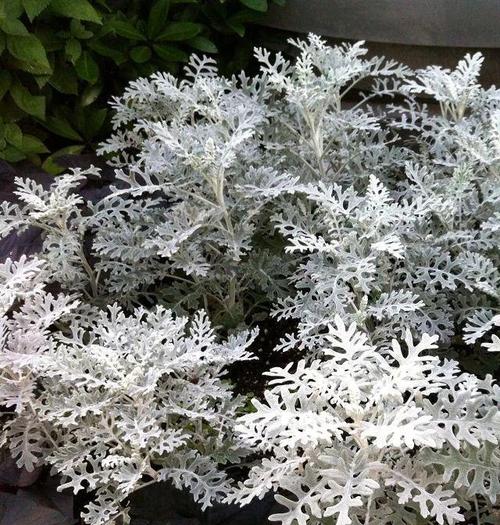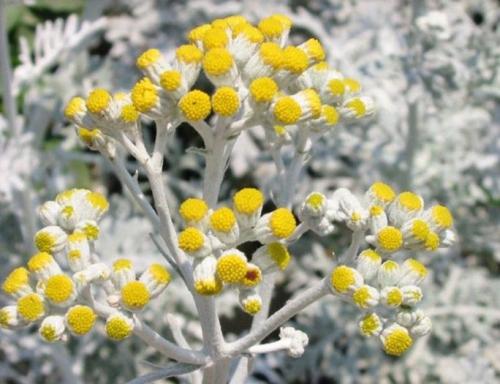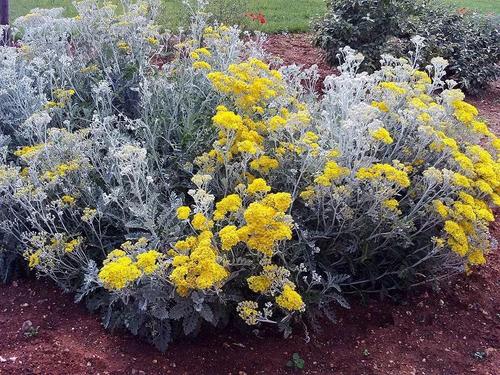Dusty Miller (Jacobaea Maritima) Profile
Written by Maggie
Nov 23 2021

Dusty Miller (Jacobaea maritima), also called silver ragwort, is a perennial herb of the genus Saliphora in the composite family. Dusty Miller is more branched, the height is generally in 50 ~ 80 cm, the leaf is one to two back pinnately splits, both sides are silvery-white pubescent. Its silvery-white leaves look like a white cloud from a distance, and other colors of pure color flowers configuration planting, the effect is excellent, is an important flower bed view leaf plants. Dusty Miller originates from Brazil. Dusty Miller has cold resistance, drought resistance, like the environment with sufficient sunlight.
Dusty Miller Picture

Dusty Miller info
| Botanical Name | Jacobaea maritima |
| Common Names | Dusty Miller, silver ragwort |
| Plant Type | Tender perennial |
| Sun | Full sun |
| Hardiness Zones | 8 to 11 |
| Flower color | Yellow |
| Native Area | Mediterranean region |
| Mature size | 6 to 18 inches |
Dusty Miller Characteristics
Dusty Miller Leaf
Dusty Miller leaves are spatulate or pinnately lobed, silvery-white pilose on both sides, thin, lobed, snowflake patterned, with long white downy hairs.
Dusty Miller Flowers
Dusty Miller is much-branched, leaves one to two pinnately split, the front and back are silvery-white pubescent, head single branch top, small, yellow flowers. (Read More about Dusty Miller Flower.)
Dusty Miller Habits
Dusty Miller (Jacobaea Maritima) can't stand the heat and is prone to death in high temperatures and humidity. They like cool wet, sunny climate and loose fertile sandy loam or clay loam rich in organic matter.
The optimum temperature for Dusty Miller's growth is 20℃-25℃, and the sprouting force is the strongest at 25℃.
Dusty Miller Care
Dusty Miller Lighting
Dusty Miller desires full solar to continue to be compact and hold their excellent foliage color. Plants developing in color are leggy and produce fewer of the hairs that provide them their silvery color.
Dusty Miller Soil Care
Dusty Miller flora adapt to a range of soils, however desirable drainage is key for healthful plants. Whether your soil is on the rocky facet or is characterised with the aid of clay, you can enhance each pH and drainage by using amending it with compost.
Dusty Miller Watering
The fuzzy increase that offers Dusty Miller its sheen additionally helps plant life stand tall in intervals of drought. Like different flowers that hail from Mediterranean climates, Dusty Miller can get through with occasional watering as soon as it is established. A layer of natural mulch will make flora even much less structured on supplemental irrigation. One inch of water per week is adequate to maintain Dusty Miller developing strength.
Dusty Miller Temperature & humidity
As a Mediterhranean plant, Dusty Miller flourishes in hot, sunny climates. Excessive humidity isn't always a trouble as long as flowers have ample spacing and a role in full sun.
Dusty Miller Fertilizer
Dusty Miller plant life are mild feeders, and solely want supplemental fertilizers in areas with very terrible soil. In this case, it is higher to feed and enhance the soil at the same time by using natural count like well-rotted manure or leaf mold.
Dusty Miller Repotting
Pot up Dusty Miller with any business potting soil. Make positive your container has drainage holes. Add a handful of peat moss to expand acidity. A layer of mulch on the soil will maintain water and preserve soil from splashing onto the leaves. It's time to report when you see roots coming out of the drainage hole.
Dusty Miller Pruning
Dusty Miller plant life requires no pruning to preserve their desirable furry shape. If you experience that the yellow blooms detract from the plants, shear them off as they appear.
How to grow Dusty Miller in containers
Dusty Miller (Jacobaea Maritima) appears great in all sorts of containers, which includes striking baskets and window boxes. The finely divided foliage appears so relatively blended with the trailing stems of petunias or million bells, and additionally make a good-looking associate plant for different solar fans like zinnias, pentas, or salvia. Keep your container in full sun, and water extra regularly than vegetation developing in the ground, at least each different day in summer.
How to grow Dusty Miller from Seeds
Fill your backyard beds with Dusty Miller by using the beginning of a flat of seeds six weeks earlier than the ultimate frost. Cover seeds gently with sterile potting mix, and develop at 70 F. You will begin to see germination in about 10 days. Plant outside eight inches aside in pots, or 10 inches apart in the ground.
Varieties of Dusty Miller
The distinction between Dusty Miller cultivars can be viewed in how dissected the foliage is. Some sorts are very lacy and fine, whilst others are solely barely lobed. 'Cirrus' has huge leaves with scalloping on the edges. 'Silverado' has the fern-like foliage famous in many gardens. 'Silver Lace' has very best foliage, as the identity implies.

Dusty Miller Propagation
Dusty Miller Seed propagation
Dusty Miller (Jacobaea Maritima) uses seeds to reproduce. Generally at the end of August and early September sowing in the open seedbed, about half a month or so buds neat, seedling growth is slow. When there are 4 true leaves, put them in 5-inch pots or transplant them into the field. Then transplant them in the spring of the next year. During growth, the height and diameter of the plant can be controlled by cutting the core.
Dusty Miller Cutting propagation
The optimal rooting temperature for dusty miller cuttings was 18℃ ~ 25℃, and lower than 18℃, it was difficult and slow for cuttings to rooting. If the temperature is higher than 25℃, the cuttings are susceptible to bacterial infection and rot, and the higher the temperature is, the greater the proportion of rot is. Cuttings encountered low temperature, insulation measures are mainly used to use the film cutting pot or container wrapped up; Cuttings after the temperature is too high, cooling measures are mainly to shade cuttings, to cover 50 ~ 80% of the sun, at the same time, to spray cuttings, 3 ~ 5 times a day, the number of sunny day higher spray is more, rainy day temperature lower temperature is larger, the number of sprays is less or not spray.
The relative humidity of air must be maintained at 75 ~ 85% after cutting. You can spray Dusty Miller cuttings to increase the humidity, 1 ~ 3 times a day, the higher the temperature on sunny days, the more times the spray, the lower the temperature on cloudy and rainy days, the fewer or no spray. But if sprayed too much, the cuttings are susceptible to disease and rot, because many kinds of disease are present in water.
Dusty Miller cutting propagation cannot be separated from sunlight irradiation, but the stronger the illumination, the higher the temperature inside the cuttings, the more vigorous transpiration of the cuttings, the more water consumed, which is not conducive to the survival of the cuttings. Therefore, after cutting must block out 50 ~ 80% of the sun, to be root grow out, and then gradually remove the shading net: a sunny day at 4:00 PM in addition to the shading net, the next day before 9:00 am covered with the shading net.
Dusty Miller Disease Control
Leaf spot
We can alternately spray 50% sterilized special wettable powder 800 ~ 1000 times liquid or 65% wettable powder 600 ~ 800 times + soft water through 1500 ~ 3000 times liquid.
Stem rot
We can be sprayed in the onset of 70% wettable powder methyl torbutine 800 ~ 1000 times + rou Shui Tong 1500 ~ 3000 times liquid or 50% benzolite 1000 times + rou Shui Tong 1500 ~ 3000 times liquid for prevention and control. (Find more winter plants here.)
Dusty Miller Distribution
Dusty Miller, originally from Brazil, is hardy along the Mediterranean coast and has spread throughout southern China, wintering on open ground along the Yangtze River basin.
Dusty Miller Toxic
Dusty Miller plants (Jacobaea Maritima) contained alkaloids such as chacobin (24 -- 6), trichlorophenine (24 -- 9), otosenine and trichlorophenine (24 -- 7) in the ground parts, and trichlorophenine (24 -- 8) in the seeds. Dusty Miller's main toxic components can be classified into the following types according to their structure:
Sesquiterpene lactones
These components are widely distributed in Compositae, mainly found in Ambrosial. Asterl., Artemisia, Asterl., Cosmoscav., Dahlias (Dahliacav.), Helianthus (Helianthus L.).
Sulphenyl derivatives and polyalkyne compounds
These compounds mainly exist in Tageteae, Helenieae and Heliantheae, which have the structure of E-terthienyt and 5 -- (3 -- butenynyl) -- 2,2, -dithienyl [5 -- (3 -- butenynyl) -- 2,2, -bithienyl].
The poisoning caused by them belongs to chronic cumulative poisoning. Symptoms include:
1. Make liver tissue necrotic;
2. Hepatic fibrous degeneration, causing edema;
3. This is a mitotic inhibited cell megalocytosis. Rats fed with 5% Seneciojacobea showed the following major pathological changes within weeks: lymphatic hyperplasia, spleen enlargement, thymus atrophy, ascites, pleural effusion, and diffuse necrotizing hepatitis. More than 90 species of di-thickened pyrrolidine alkaloids are known in Compositae plants. The toxicity of some of the main representatives is shown in Table 24 -- 1..-, poisonous di-thick pyrrolidine alkaloids often have 1, 2-dehydropyrrolidine rings containing alkyl branches, often containing hydroxyl or ester groups at position 7, which may be part of the allyl ester on the supranuclear alkyl chain, such as pidacitrin (24 -- 7). Cyclic diester is the most toxic, cyclic single ester is the second, single ester is the least toxic. The poisoning reactions of different domestic animals are also different. Pigs are the most sensitive, while chickens, cattle and horses are not. Sheep are tolerant to chronic poisoning but sensitive to acute poisoning.

Read Next:
Top 10 Most Beautiful Roses in the World
Top 10 Most Beautiful Flowers in the World
26 Best Autumn Flowers to Plant for Fall Color in Garden
10 Best Winter Plants to Brighten Your Winter Garden
Latest Updated
- Benefits of Bugleweed - 7 Science-backed Health Benefits
- Bugleweed Dangers & Side Effects - Is It Poisonous?
- How to Plant Evergreen Trees - What You Should Know
- When to Plant Evergreens - Grow Guide for Evergreen Trees
- 12 Wonderful Evergreen Shrubs for Your Garden
- 12 Popular Evergreen Plants with Pictures for Beginners
- When And How To Prune A Lilac Bush Like a Pro
- How to Grow & Care for Lilac Vine (Hardenbergia Violacea)
- Japanese Lilac Tree (Syringa Reticulata) Care & Propagation Guide
- Shumard Oak Pros and Cons - What to Know
Popular Articles
- Winter maintenance of Antirrhinum Majus
- How to Grow Terminalia Mantaly Tree
- How to Grow and Care for Crossostephium Chinense
- How to grow Antirrhinum Majus in spring
- Peristeria Elata (Dove Orchid) Profile: Info & Care Guide
- Underwatered Snake Plant (Sansevieria Trifasciata) - Signs And How To Fix
- How to Care for Brazilian Jasmine Plant (Mandevilla Sanderi)
- How to Grow & Care for Graptopetalum Purple Delight in Summer
- Rosa Chinensis (China Rose): Plant Growing & Care Tips
- How to Care for Baby Sun Rose (Aptenia Cordifolia)